MARKET OVERVIEW
The Global Pressure Ulcer Prevention market is now poised to grow beyond conventional boundaries to areas that were never deemed fit for industry intervention. A dynamic healthcare environment calls for the exploration of newer arenas, areas where preventive strategies for skin integrity are integrated not just as imperatives but as attack points for operational efficiency and patient outcomes. The industry is going to cease to operate only within hospitals and long-term care facilities and will extend to domains like mobility, lifestyle, or even occupational health.
The adoption of technology will steer this market into unconventional spaces. Wearables with advanced pressure-mapping sensors, AI-based monitoring platforms, cloud-enabled patient tracking systems-they all should be moving into private homes, transportation services, and athletic environments. The concept of pressure injury prevention will be expanded to one that looks at a larger pool rather than the elderly or immobile. Persons with sedentary work would benefit, as would athletes recovering from injury and outpatients undergoing rehabilitation, from customized solutions for pressure ulcer prevention that passively work in the background of life.
Another key domain is going to be architectural design and material sciences, where the Global Pressure Ulcer Prevention market will stretch its scope. Hospital infrastructure and furnishings in the twenty-first century will be equipped with smart materials capable of adjusting to the patients' physical states. Innovation will also be applied to chairs and mobility aids with dynamic surface pressure redistribution systems, directed by real-time analytics and patient-specific risk algorithms. Such embedded technology will also be considered in the home interior, ambulances, and assisted-living facility designs, thus widening the market beyond pressure care strategies previously neglected.
In addition, partnerships between technology companies and health services will change the paradigm of how data is used within this field. Through machine learning, it will be possible to predict potential cases well before any physical manifestation is apparent to inform policy and procurement decisions. The aggregation of big data will develop early warning systems not only for individual patients but also for whole facilities/populations. Insurance providers will then join the conversation, finding an interest in underwriting plans that include pressure ulcer prevention devices and services as core offerings, thereby positioning the market outside traditional sales.
Advocacy and education initiatives will encourage this transition. To the degree that public knowledge increases, so will consumer demand for preventive solutions not limited to prescriptions but arising from informed selections. Such a shift in demand dynamics will give rise to new consumer-facing business models.
Global Pressure Ulcer Prevention market is estimated to reach $1,616.22 Million by 2032; growing at a CAGR of 4.3% from 2025 to 2032.
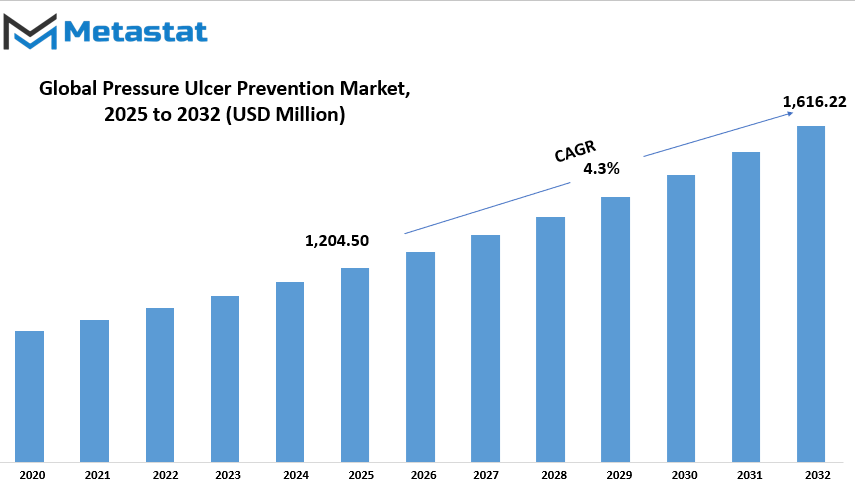
GROWTH FACTORS
There are primary reasons attributed to this development along with a number of factors that contribute actively towards the steady growth of the Global Pressure Ulcer Prevention market. One of the major reasons among these is the increasing aging population worldwide. As age increases with the passing years, the mobility of a person may be limited; age-related diseases affecting human health make the person vulnerable to pressure ulcers. The growing aging population is thus creating a sustainable demand for high-performing prevention solutions, including specialty mattresses, cushions, and support surfaces that can help reduce the risk of skin breakdown.
Increased hospitalizations are another very strong driving force for this market. This creates a null environment everywhere in terms of the short and long-term treatment to be delivered to a person, leading to an inclusion of preventive management of bedsores as part of the routine care of the patient. Many hospitals as well as facilities are investing heavily in pressure ulcer preventive tools, not only for the sake of the patient but also for reasons that are more practical in terms of avoiding complications that lead to longer stay and increased costs.
Some of the factors have posed challenges to holding back the market, though growth has been steady. One of the major hurdles is the cost of advanced devices. Equipment like smart mattresses and air-fluidized beds comes at a high price, which makes it difficult for smaller healthcare centers or homes in low-income areas to access them. Costs may also deter some patients and caregivers from investing in preventive solutions, even if needed.
Awareness is another big problem in developing parts of the world. These areas are completely ignorant concerning the seriousness of pressure ulcers or how to prevent them. This lack of knowledge is very much responsible for slow growth in the market, as the demand for the products is lower without better education and outreach.
On the other hand, the future holds many opportunities. Most recently, there has been ongoing development in technology, especially smart ones using sensors and monitoring systems for the purposes of movement tracking and early detection of pressure damage. This will certainly assist in making this primary prevention effective and easy to manage. With further access to these tools, attention is expected to be directed toward them from the professionals and the home users.
Still, many emerging countries remain untapped. Companies who manufacture or sell products related to preventing pressure ulcers will benefit greatly from these countries to expand and continue their existence. The right strategies and affordable options can reach and introduce more people to improve care in these needy areas. Thus, this combination of opportunities and challenges is defining a way into the future of the Global Pressure Ulcer Prevention market.
MARKET SEGMENTATION
By Product Type
The Global Pressure Ulcer Prevention Market is said to be rightly gaining momentum with the awareness of patient care and safety. Pressure ulcers, otherwise known as bedsores, are a major concern among bed-bound and semi-mobile individuals who require maximum care. These ulcers can give rise to serious health problems if not treated properly and this demand has been tempting the market further. Hospitals, nursing homes, and home care settings are entering the stream of promoting the prevention of these ulcers, which is yet another plus to the market. The array of products available assists healthcare professionals in selecting what is most appropriate for their patients for comfort and risk minimizing.
Considering product types, the market is segmented into multiple categories. Static Support Surfaces definitely constitute a significant part, worth $403.49 million. These surfaces equally distribute weight and relieve pressure from vulnerable spots over the body. In hospitals and care homes, these surfaces are widely used as they are easy to maintain and cater to a cost-effective solution. Another major product is Dynamic Support Surface. These are powered devices that eliminate pressure and promote blood flow alternately, typically marketed to patients at greater risk and considered more expensive but in many instances effective.
Dressing also considerably prevents pressure ulcers. Dressings provide a protective shield on the surface of the skin, thus helping to regulate moisture and prevent skin tissue breakdown. Moisture management is essential here as wet skin is more susceptible to injury. Using dressing and positioners, along with some protectors, is crucially important in minimizing the pressure on certain parts of the body. The function of these devices is to facilitate body alignment and reduce the risk of sores by relieving constant pressure from one area.
Creams are an important segment in prevention programs. These substances are used to keep the skin hydrated and to create a shield against irritants. Continuous application of such creams enhances skin strength and prevents skin damage. The next in the market class include anything that cannot exactly be included in the above categories but might be used as a part of a wider approach towards prevention. As awareness and knowledge in pressure ulcer prevention continue to burgeon, the market for these products will continue to thrive, with an increase in healthcare providers investing in better solution techniques for patient safety and comfort.
By End User
Globally, the need for various healthcare settings defines the market for Pressure Ulcer Prevention products, and end users determine their application and major development considerations. This market is segmented into Hospitals & Ambulatory Surgery Centers, Clinics, Long-Term Care & Urgent Care Centers, and Others. Each type of setting exhibits unique demands, priorities, and challenges, thus providing guidance to the market and forcing the adaptation of products to fit real-world use. Hospitals and Ambulatory Surgery Centers represent the largest consumers of pressure ulcer prevention products. These facilities treat a high number of patients with serious health conditions that generally require protracted bed rest or limited mobility. Because of this, pressure ulcer risk is also higher and there is therefore an urgent need for effective solutions, for instance, pressure-relieving mattresses, cushions, and support surfaces. These centers generally have adequate budget provisions and infrastructure to invest in new systems, thus motivating companies for more innovation.
The clinics also play their part in the market but rather as a specialized niche. While they don’t usually take care of patients with long-term immobility, they do need minimum implements and techniques for early prevention and risk assessment. Clinics often use educational materials, simple support aids, and early intervention methods. Their role may be small, but it is practically significant when it comes to the identification of patients at risk before the development of ulcers.
Long Term Care and Urgent Care Centers do make up another major part of the market. These centers take in patients who may not have acute illnesses but who will endure very long recovery times or have chronic conditions restricting their mobility. In these settings, pressure ulcer prevention is not just about the equipment, it is also about the routines, staff training, and continuous monitoring of the patients. These centers rely on a combination of both products and procedures to reduce risk and increase comfort.
The 'Others' category consists of home healthcare providers and rehabilitation centers, where care is often more individualized. Products used here should be simple to operate and cost-effective while remaining reliable. As increasing numbers of individuals opt to recuperate at home or receive care outside of the conventional hospital route, it is anticipated that this niche sector will witness continued growth.
Across all these settings, the need for pressure ulcer prevention is driven by the unmet goal of improving patient outcomes while reducing complications. With the growing awareness, each end-user type is bound to continue to influence the market in its own unique way.
|
Forecast Period |
2025-2032 |
|
Market Size in 2025 |
$1,204.50 million |
|
Market Size by 2032 |
$1,616.22 Million |
|
Growth Rate from 2025 to 2032 |
4.3% |
|
Base Year |
2024 |
|
Regions Covered |
North America, Europe, Asia-Pacific, South America, Middle East & Africa |
REGIONAL ANALYSIS
Trends and developments in healthcare worldwide have their own regional implications that affect the overall global pressure ulcer prevention market. It has been segmented on the grounds of regions into North America, Europe, Asia Pacific, South America, and the Middle East Africa region. Every market is shaped by a unique set of factors, consequently leading to varied needs, policies, and access to healthcare solutions across such regions. The North American section is further segmented into the U.S., Canada, and Mexico. The most advanced medical system mainly drives the U.S. segment, high awareness of the general population on pressure ulcers, and government funding. Canada has great potential due to its emphasis on public health, while Mexico, which is adding on gradually health coverage, will drive this market in the next few years.
Europe comprises the UK, Germany, France, Italy, and the Rest of Europe. These countries gain from good healthcare services, old population, and strict safety regulations in hospital and care homes. In Germany and France, a steady growth is projected due to their investment in medical equipment and training. Pressure ulcer management has drawn substantial attention in the UK with increasing awareness and continued government support. The overall improvement of the healthcare sector in Italy and the region is anticipated to have an overall positive impact on the market.
Asia-Pacific is segmented into India, China, Japan, South Korea, and the Rest of Asia-Pacific. This area has high potential because of its sheer size in terms of density with a large population and settings for enhancing income levels with healthcare infrastructure. Advanced hospital systems with a high elderly population in Japan and South Korea have contributed to an increased utilization of pressure ulcer prevention tools. Growth in healthcare investments in China and India will contribute to addressing the ever-increasing demand. Awareness is developing in some parts of it, while the region is progressing fast.
The market in South America consists of Brazil, Argentina, and the Rest of South America. Brazil is the major country contributing, propelled by the best hospital facilities for curative health services and public health campaigns. Argentina is also showing signs of progress with slow but steady improvements in health care delivery services. With a lot of challenges like economic instability, the demand for better patient care will push the market upward.
Comprising the GCC countries, Egypt, South Africa, and the Rest of the Middle East and Africa, the Middle East and Africa still seem to be catching up; however, slowly but steadily, increased focus is becoming apparent toward improving hospital safety and infrastructure. Leading the way are the GCC countries and South Africa, while Egypt seems to show promise in developing its health care, through its health development plan.
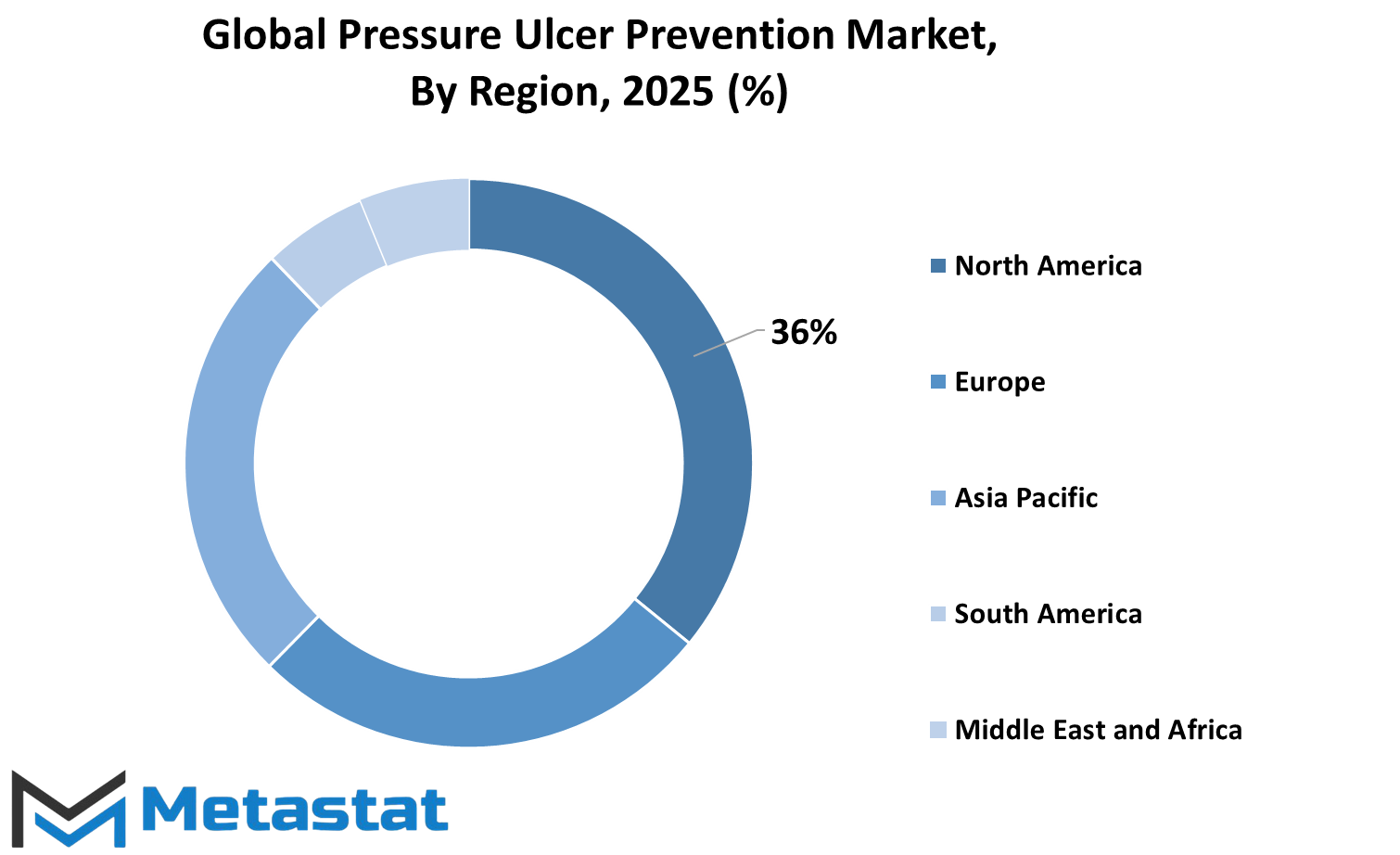
COMPETITIVE PLAYERS
The market found in Pressure Ulcer Prevention is globally emerging and will develop itself due to the gradual rise in demand for effective healthcare solutions. Pressure ulcers are basically injuries to the skin and underlying tissue caused by persisting pressure over a region in the skin. This injury may result from being bedridden or limited mobility status. It has been an ever-growing concern of hospitals, nursing homes, and home care settings regarding preventing these ulcers. Awareness is growing, and the trend among healthcare providers increasingly focuses on such products and techniques, which would help reduce the risk of acquiring such painful and preventable wounds.
It is a pressure ulcer prevention market, which indeed comprises an array of products such as specialty mattresses, cushions, dressings, mobility aids, and so on. Such systems are in place to relieve pressure, improve circulation for, and sustain skin health. Given this priority, most hospitals and care centers are now striving to incorporate these drug regimens in their patient comfort scopes to avert complications that result from untreated ulcers. This trend of preventing complications not only means that better quality care is given but also that patients spend less time admitted into hospital facilities, resulting in reduced medical bills.
Mölnlycke Health Care AB, 3M, Smith & Nephew Plc, Integra LifeSciences, Ulcer Solutions, LLC, DHG, Arjo, Invacare Corporation, Stryker, and Baxter are among the important players that are described as the users and players in the pressure ulcer prevention market industry. These companies continue to strive toward new and better technologies, considering the needs and in consideration of the developing demand for pressure ulcer prevention. Internal focus aims at innovations in advanced dressing types, enhanced support surfaces, and devices that track patient's activity and pressure levels. Offering many products for different needs would make it easier for healthcare providers to choose the most suitable sedation treatment option.
The developing age-dominant population across the globe in such countries, along with developing chronic diseases, has increased the prevalence of people at risk of pressure ulcers. This has encouraged governments and healthcare systems to focus more attention on the elements of preventive care; thus, their inclination towards the promotion of adoptions of pressure-relieving equipment and options for better periodic monitoring of patients would further boost market growth.
Overall, we see that this market of Pressure Ulcer Prevention will see greater awakening in its importance as providers will refer to it more as the means to achieve better outcomes for their patients. Zest continues to pay attention to this global industry and recognizes the role of preventing injuries at the early stages.
Pressure Ulcer Prevention Market Key Segments:
By Product Type
- Static Support Surfaces
- Dynamic Support Surfaces
- Dressings
- Positioners & Protectors
- Creams
- Others
By End User
- Hospitals & Ambulatory Surgery Centers
- Clinics
- Long Term Care & Urgent Care Centers
- Others
Key Global Pressure Ulcer Prevention Industry Players
- Mölnlycke Health Care AB
- 3M
- Smith & Nephew Plc
- Integra LifeSciences
- Ulcer Solutions, LLC
- DHG
- Arjo
- Invacare Corporation
- Stryker
- Baxter
WHAT REPORT PROVIDES
- Full in-depth analysis of the parent Industry
- Important changes in market and its dynamics
- Segmentation details of the market
- Former, on-going, and projected market analysis in terms of volume and value
- Assessment of niche industry developments
- Market share analysis
- Key strategies of major players
- Emerging segments and regional growth potential



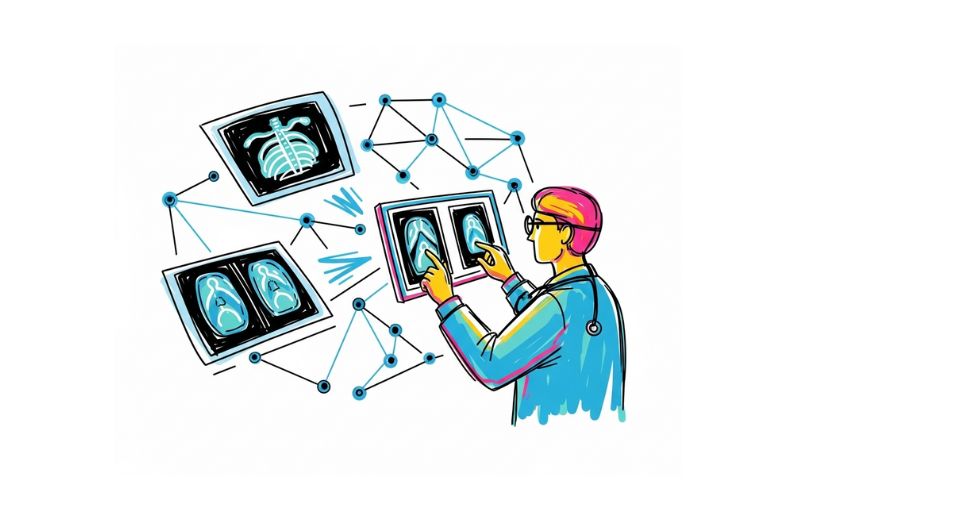
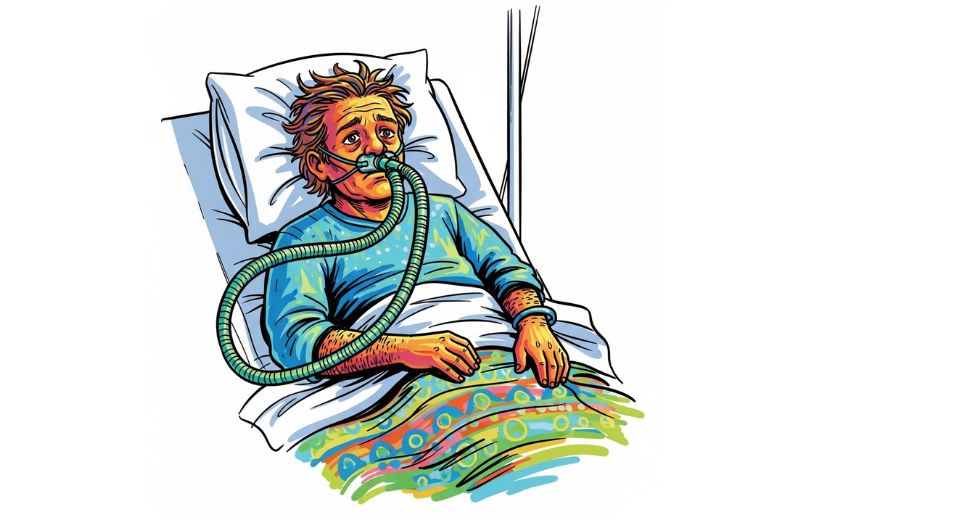
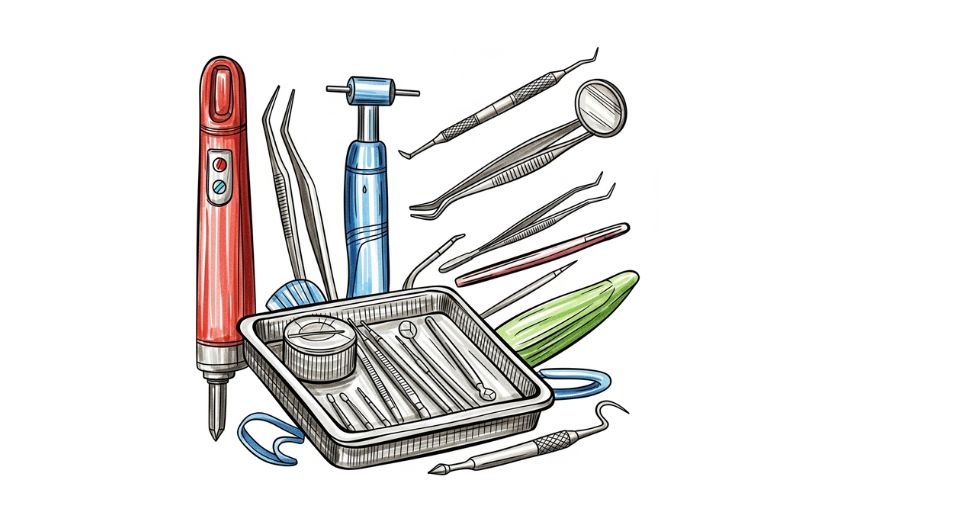


 US: +1 3023308252
US: +1 3023308252






